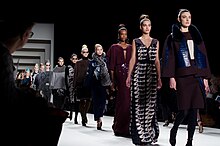The most prominent fashion weeks are held in the fashion capitals of the world: sequentially, New York, London, Madrid, Milan and Paris. Other notable weeklong fashion events are held in cities around the world.

History
There are many fashion weeks worldwide. In 1943, the first New York Fashion Week was held, with one main purpose: to distract attention from French fashion during World War II, when workers in the fashion industry were unable to travel to Paris. This was an opportune moment, as "before World War II, American designers were thought to be reliant on French couture for inspiration."
The fashion publicist Eleanor Lambert organized an event she called "Press Week" to showcase American designers for fashion journalists, who had previously ignored their works. Press Week was a success, and, as a result, magazines like Vogue (which were normally filled with French designs) began to feature more and more American innovations. Until 1994, shows were held in different locations, such as hotels, or lofts. Eventually, after a structural accident at a Michael Kors show, the event moved to Bryant Park, behind the New York Public Library, where it remained until 2010, when the shows relocated to Lincoln Center.
However, long before Lambert, there were fashion shows throughout America. In 1903, a New York City shop called Ehrich Brothers put on what is thought to have been the country’s first fashion show to lure middle-class females into the store.[5] By 1910, many big department stores were holding shows of their own. It is likely that American retailers saw that they were called 'fashion parades' couture salons and decided to use the idea. These parades were an effective way to promote stores, and improved their status. By the 1920s, the fashion show had been used by retailers up and down the country. They were staged, and often held in the shop’s restaurant during lunch or teatime. These shows were usually more theatrical than those of today, heavily based upon a single theme, and accompanied with a narrative commentary. The shows were hugely popular, enticing crowds in their thousands – crowds so large, that stores in New York in the fifties had to obtain a license to have live models.
Paris began holding couture shows in 1945, Milan Fashion Week was founded by the Italian Chamber of Commerce in 1958,[7] Paris Fashion Week was further organized in 1973 under the French Fashion Federation,[8] and London Fashion Week was founded by the British Fashion Council in 1984.[9]
Although these key organizations still organize most shows, there are independents and multiple producers in all cities, as well.[10]
Characteristics
Fashion week happens twice a year in the major fashion capitals of the world: New York, London, Milan and Paris (in that order). Fashion weeks are held several months in advance of the season to allow the press and buyers a chance to preview fashion designs for the following season. In February and March, designers showcase their autumn and winter collections. Fashion week for spring and summer is held in September and October. This is also to allow time for retailers to arrange to purchase or incorporate the designers into their retail marketing. The latest innovations in dress designs are showcased by renowned fashion designers during these fashion weeks, and all these latest collections are covered in magazines such as Vogue.
New York, London, Milan and Paris each host a womenswear fashion week twice a year, with New York beginning each season and the other cities following in the aforementioned order. London, Milan, Paris and Milan host menswear showcases, as does Florence, in the form of Pitti Immagine Uomo.
There are two major seasons per year: Autumn/Winter and Spring/Summer.
For womenswear, the Autumn/Winter shows always start in New York in February and end in Paris in March. Spring/Summer shows start in New York in September and end in Paris in October. Menswear shows happen in January and summer months, while Paris' womenswear haute couture shows take plane in Paris in January and July.[11] (Due to rules rules set down by the Chambre Syndicale de la Haute Couture, haute couture can only be shown in Paris.)
More and more designers have shown inter-seasonal collections between the traditional Autumn/Winter and Spring/Summer seasons. These collections are usually more commercial than the main season collections and help shorten the customer's wait for new season clothes. The inter-seasonal collections are Resort/Cruise (before Spring/Summer) and Pre-Fall (before Autumn/Winter). There is no fixed schedule for these shows in any of the major fashion capitals but they typically happen three months after the main season shows. Some designers show their inter-seasonal collections outside their home city. For example, Karl Lagerfeld has shown his Resort and Pre-Fall collections for Chanel in cities such as Moscow, Los Angeles and Monte Carlo instead of Paris. Many designers also put on presentations as opposed to traditional shows during Resort and Pre-Fall either to cut down costs or because they feel the clothes can be better understood in this medium.
Some fashion weeks can be genre-specific, such as Miami Fashion Week (swimwear), Rio Summer (swimwear), the haute couture shows in Paris (one-of-a-kind designer originals), Festive Wear at Bangalore Fashion Week and Bridal Fashion Week, while Portland (Oregon, USA) Fashion Week shows some eco-friendly designers. Bread and Butter Berlin hosts the leading fashion show for everyday fashion.
Dengan adanya informasi yang kami sajikan tentang fashion week
, harapan kami semoga anda dapat terbantu dan menjadi sebuah rujukan anda. Atau juga anda bisa melihat referensi lain kami juga yang lain dimana tidak kalah bagusnya tentang #SuzyPFW: Olympia Le-Tan - An Ode To Tokyo
. Sekian dan kami ucapkan terima kasih atas kunjungannya.
buka mesin jahit : https://en.wikipedia.org/wiki/Fashion_week
 |
| Fashion week |



0 komentar:
Post a Comment